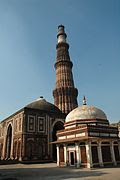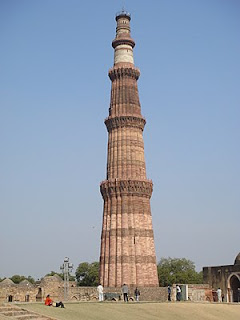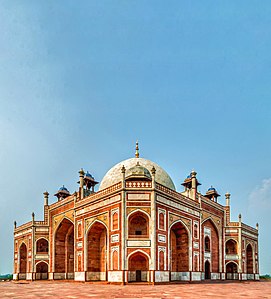Qitub-ud-Din Aibak
Qutub Minar
The Qutb Minar also spelled as Qutab Minar or Qutub Minar, is a minaret that forms part of the Qutb complex, a UNESCO World Heritage Site in the Mehrauli area of Delhi, India.
Qutb Minar is a 73-meter (239.5 feet) tall tapering tower of five stories, with a 14.3 meters (47 feet) base diameter, reducing to 2.7 meters (9 feet) at the top of the peak. It contains a spiral staircase of 379 steps.
The Minar is surrounded by several historically significant monuments of Qutb complex. The nearby pillared cupola was known as "Smith's Folly" is a remnant of the tower's 19th-century restoration, which included an ill-advised attempt to add some more stories.
Qutub Minar
The minor's topmost story was damaged by lightning in 1369 and was rebuilt by Firuz Shah Tughlaq, who added another story. In 1505, an earthquake damaged Qutub Minar; it was repaired by Sikander Lodi. On 1 September 1803, a major earthquake caused serious damage. Major Robert Smith of the British Indian Army renovated the tower in 1828 and installed a pillared cupola over the fifth story, thus creating a sixth. The cupola was taken down in 1848, under instructions from Viscount Hardinge, then Governor-General of India. It was reinstalled at ground level to the east of Qutb Minar, where it remains. It is known as "Smith's Folly".
Architecture
The transformed tower's style is patterned on Afghanistan's Minaret of Jam, and adapted to local artistic conventions by incorporation of "looped bells and garlands and lotus borders into the carving". Numerous inscriptions in Parso-Arabic and Nagari characters in different sections of the Qutb Minar reveal the history of its construction and the later restorations and repairs by Firoz Shah Tughluq (1351–89) and Sikandar Lodi[10] (1489–1517).
The tower has five superposed, tapering stories. The lowest three comprise fluted cylindrical shafts or columns of pale red sandstone, separated by flanges and by storeyed balconies, carried on Muqarnas corbels. The fourth column is of marble and is relatively plain. The fifth is of marble and sandstone. The flanges are a darker red sandstone throughout and are engraved with Quranic texts and decorative elements. The whole tower contains a spiral staircase of 379 steps. At the foot of the tower is the Quwat ul Islam Mosque. The seminar tilts just over 65 cm from the vertical, which is considered to be within safe limits, although experts have stated that monitoring is needed in case rainwater seepage further weakens the foundation.
Qutb Minar was an inspiration and prototype for many minarets and towers built after it. Chand Minar and Mini Qutub Minar bears resemblance to the Qutb Minar and were inspired by it.
Accident
Before 1974, the general public was allowed access to the top of the minaret, via the internal staircase. On 4 December 1981, the staircase lighting failed. Between 400 and 500 visitors stampeded towards the exit, and 47 were killed in the crush and some were injured. Most of these were school children. Since then, the tower has been closed to the public. Now it is said the tower is haunted. One lady who managed to sneak in the tower is said to be overtaken by a paranormal force who then jumped off the topmost floor of the tower and committed suicide. Since this incident, the rules regarding entry has been stringent.
In literature
Wikisource has original text related to this article:
'The Cootub Minah, Delhi',
a poem by L. E. L.
Letitia Elizabeth Landon's poem The Qutub Minar, Delhi is a reflection on an engraving in Fisher's Drawing Room Scrap Book, 1833.
In popular culture
 Bollywood actor and director Dev Anand wanted to shoot the song "Dil Ka Bhanwar Kare Pukar" from his film Tere Ghar Ke Samne inside the Minar. However, the cameras in that era were too big to fit inside the tower's narrow passage, and therefore the song was shot inside a replica of the Qutb Minar
Bollywood actor and director Dev Anand wanted to shoot the song "Dil Ka Bhanwar Kare Pukar" from his film Tere Ghar Ke Samne inside the Minar. However, the cameras in that era were too big to fit inside the tower's narrow passage, and therefore the song was shot inside a replica of the Qutb Minar
The site served as the pit stop of the second leg of the second series of The Amazing Race Australia.
A picture of the minaret is featured on the travel cards and tokens issued by the Delhi Metro Rail Corporation. A recently launched start-up in collaboration with the Archaeological Survey of India has made a 360o walkthrough of Qutb Minar available.
Ministry of Tourism recently gave seven companies the 'Letters of Intent' for fourteen monuments under its 'Adopt a Heritage Scheme.' These companies will be the future 'Monument Mitras.' Qutb Minar has been chosen to part of that list.





Comments